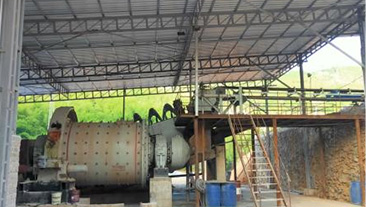
Copper ore is one of the important minerals and is widely used in various industries. With the gradual reduction of high-grade and high-quality copper ore resources, it is necessary to continuously improve and optimize the copper ore dressing process to improve the utilization rate of copper ore resources. Since there are many types of copper ores in nature, such as malachite, chalcocite, bornite, etc., the selection of copper ore dressing process should be based on the specific ore type and characteristics. Common copper ore dressing technologies include: flotation, gravity separation, leaching and combined dressing. Efficient dressing equipment is another important factor in improving the efficiency of copper ore dressing. Xinhai Mining has been committed to copper ore dressing for more than 20 years and has completed the design and construction of multiple copper ore dressing plants. The following will introduce you to copper ore dressing technology, equipment and Xinhai Mining's successful cases to help you better understand copper ore dressing.

The principle of copper ore flotation is to utilize the physical and chemical properties differences between copper minerals and other impurity minerals, and to combine copper minerals with foam by adding appropriate flotation agents and foaming agents, thereby separating them from other impurity minerals. Specifically, the flotation agent can generate a layer of hydrophobic substances on the surface of the copper mineral, while the foaming agent can make the foam have sufficient stability and adsorption, thereby achieving the purpose of effective separation during the flotation process.
Modern copper ore flotation reagents involve many kinds of reagents, including collectors, foam stabilizers, regulators, dispersants, potions, etc. New flotation reagents can change the surface properties and chemical properties of minerals, thereby achieving the purpose of improving flotation recovery.
Applicable minerals: refractory copper oxide ores, copper sulfide ores, mixed copper ores and complex copper-containing ores

Leaching processes include heap leaching, in-situ leaching (in-situ leaching is divided
into in-situ leaching and on-site leaching), percolation leaching and stirring leaching.
Heap leaching and in-situ leaching are the most widely used, while percolation leaching
and biological stirring leaching are less used.
Heap leaching is a simple, cost-effective technology for recovering copper from
low-grade copper ore. Due to its low production cost, it has been widely used in
industrial production. Some copper mines even use heap
leaching-extraction-electrodeposition to completely replace the original conventional
beneficiation method.
Underground leaching is an ore processing technology that combines mining, selection and
smelting. Underground leaching is divided into in-situ leaching and underground crushing
leaching.
Applicable minerals: low-grade oxidized copper ore

Gravity separation technology (gravity separation) is a separation method based on the density difference between minerals and gangue. In the processing of copper ore, gravity separation technology is usually used as a pretreatment method to enrich coarse-grained copper minerals or remove waste rock to reduce the burden of subsequent beneficiation processes. However, single gravity separation technology has limited effect in the treatment of copper ore, and usually needs to be combined with flotation, electrostatic separation or chemical separation processes to improve copper recovery.
Applicable minerals: oxidized copper ore, coarse-grained copper sulfide ore, mineral combinations with obvious density differences

Due to the wide variety of occurrence states of copper and its certain complexity, it is often difficult to achieve ideal results by using a single conventional flotation process. Through the cooperation of various means such as stage grinding, reagent system adjustment, and enhanced flotation, the flotation operation effect can be improved and the recovery rate can be increased. In addition, a comprehensive treatment method is often selected, such as a combination of flotation and metallurgy or chemical beneficiation.
Applicable ore types: copper ores with other valuable metal minerals
There are many kinds of crushing equipment in xinhai, jaw crusher and cone crusher are often used in copper ore crushing process.
Xinhai has successfully produced the leading high-efficient hydrocyclone in the world, which can be combined with each other for adapting to different process requirements. The thickening and dewatering efficiency was up to 80% ~ 90%; At the same time, the hydrocyclone was lined with Xinhai wear-resistant rubber that extended service life of 2-4 times.
As the world's leading thickener manufacturer, Xinhai has successfully developed various types of rake, deep cone and tilted plate thickeners, covering a free settling range of 20-3500㎡, fully meeting the needs of various ores and different scales of production.
Xinhai has developed and improved various types of filters and dewatering screens, fully ensuring that the concentration of concentrate and tailings meets the standards. The moisture content of concentrate can be reduced from the original 45-60% to 10-18%, and has successfully applied for a number of national patents.
Two-and half-stage closed-circuit crushing - one-stage closed-circuit grinding - flotation process of one-stage roughing, two-stage scavenging and two-stage concentration - two-stage mechanical dewatering



One-stage crushing-grinding and classifying-flotation (one-stage roughing, two-stage concentration and three-stage scavenging)



Flotation process(one-stage roughing, two-stage scavenging and three-stage concentration)


To find out more about our products and solutions, please fill out the form below and one of our experts will get back to you shortly.